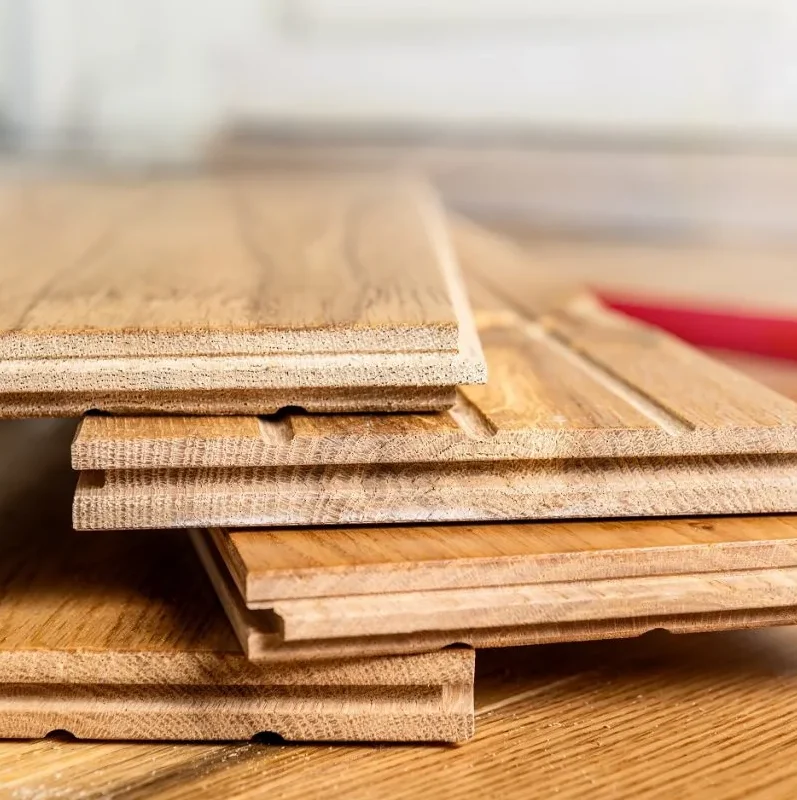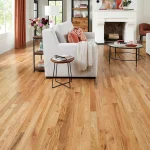- September 17, 2024
To choose between hardwood and engineered hardwood, you must understand their differences. Hardwood floors, crafted from solid timber, offer timeless beauty and longevity. They can be sanded and refinished many times. It enhances their lifespan and maintains their classic appeal.
Engineered hardwood has a real wood top layer over a high-density fiberboard or plywood core. This design handles humidity and temperature changes better than solid wood. As a result, engineered hardwood is versatile for various environments.
So, the best choice depends on your home’s climate, budget, and aesthetic preferences. This article will explore each type’s key features, benefits, and potential drawbacks.
Pros and Cons | Engineered Hardwood vs. Hardwood
Hardwood Floors | Engineered Hardwood | |
Pros | – Timeless beauty and elegance | – More moisture and temperature-resistant |
– Can be sanded and refinished multiple times | – Versatile installation options (floating, glue-down, nailing) | |
– Increases home value and appeal | – Easier and quicker installation | |
– Wide variety of wood species and finishes | – Generally lower initial cost | |
– Long lifespan with proper care | – Often features pre-finished and exotic wood veneers | |
Cons | – Higher initial cost | – Limited refinishing due to thinner veneer |
– Requires professional installation and subfloor preparation | – Less authentic wood feel compared to solid hardwood | |
– Susceptible to scratches and water damage | – Can be less durable in high-traffic areas if not high-quality | |
– Refinishing can be costly and labor-intensive | – May not match the longevity of solid hardwood | |
– Not ideal for areas with high moisture or temperature fluctuations | – Can be affected by environmental changes if not high-quality |
What is Hardwood Flooring?
Hardwood flooring is made entirely from solid pieces of natural wood, cut into planks. It showcases the unique grain patterns and beauty inherent to each wood species. Oak, maple, and cherry are the popular hardwood types used for flooring. Oak is popular for its durability and varied grain patterns. Maple offers a smooth, light appearance. Cherry is known for its rich, deep tones that darken beautifully over time.
Each type of hardwood has distinct characteristics that contribute to the floor’s aesthetic and performance. Solid hardwood flooring can be sanded and refinished many times. It allows homeowners to maintain its appearance and extend its lifespan. Those seeking a long-lasting, premium flooring solution prefer this flooring.
What is Engineered Hardwood Flooring?
Engineered hardwood flooring is composed of a top layer of wood veneer. This layer is bonded over many layers of high-density fiberboard or plywood. The multi-layer construction gives engineered hardwood greater stability. It also provides resistance to changes in humidity and temperature compared to solid hardwood. The core layers are arranged in a cross-grain configuration. It enhances the floor’s structural integrity, reducing the likelihood of warping or cupping.
Also Read: How Much Does Hardwood Flooring Cost in 2024?
Engineered hardwood is a versatile choice for various environments. It includes basements and areas with fluctuating moisture levels. The top layer of wood provides the same aesthetic appeal as solid hardwood. It allows homeowners to enjoy the natural beauty of wood. It also provides added durability and flexibility.
Durability and Longevity
Solid hardwood floors are known for their impressive lifespan. They can last several decades or even a lifetime with proper care. Solid hardwood offers excellent wear resistance. It can be sanded and refinished many times. It allows homeowners to maintain a hardwood appearance and address damage over the years. This ability to refinish and restore contributes to its long-term value and appeal.
In contrast, engineered hardwood handles environmental fluctuations better than solid wood. Its multi-layer construction enhances resistance to warping and moisture. It is suitable for areas with varying humidity levels. However, engineered hardwood typically has a thinner veneer layer than solid hardwood.
It limits the number of times it can be refinished. Engineered hardwood can be sanded and refinished, but less often. It may not restore as well as solid wood.
Cost Comparison
Solid hardwood generally has a higher initial cost. It is due to the premium quality of the natural wood. The intricate craftsmanship involved also adds to the cost. Installation costs for solid hardwood can also be significant. Professional installation ensures proper handling and a flawless finish. However, solid hardwood offers notable long-term value.
In contrast, engineered hardwood typically has a lower initial cost. It is because of its multi-layer design and cheaper core material. Engineered hardwood is also easier and quicker to install. It can further reduce overall costs. Its durability and resistance to environmental fluctuations enhance its cost-effectiveness. These features can lower maintenance and repair expenses.
Installation Process
Solid hardwood flooring typically requires professional installation due to its complexity. A proper subfloor is essential, as it must be clean, dry, and level to ensure a stable base. The installation often involves nailing the planks directly into the subfloor. It requires precision and expertise. This method is less flexible. It necessitates skilled labor to achieve a flawless finish.
In contrast, engineered hardwood offers greater flexibility and is more DIY-friendly. You can install it using various methods – floating, gluing, or nailing. It depends on the specific product and subfloor conditions. The floating installation method is popular among DIYers. In this method, planks are laid over an underlayment and click together. It is favored for its simplicity and minimal need for tools.
Engineered hardwood can also be glued down or nailed. It provides versatility for different settings and preferences. The variety of installation options makes engineered hardwood more accessible. It is a good choice for homeowners who want to handle the project themselves.
Aesthetic and Design Options
Solid hardwood flooring offers a diverse array of wood species. Each species has unique characteristics and grain patterns. Homeowners can choose from traditional options like oak and maple. They can also opt for more exotic choices such as cherry or walnut. Additionally, hardwood floors come in various finishes. These finishes range from natural and matte to glossy and distressed. This variety allows for extensive customization. The width of the planks also varies. It provides further flexibility in achieving the desired look.
Engineered hardwood offers a range of design options. It also has its distinct advantages. It often features a broad selection of appearances, including pre-finished options. These pre-finished options streamline the installation process. Engineered hardwood can also showcase exotic wood veneers.
Environmental Impact
Solid hardwood flooring, while prized for its natural beauty, raises sustainability concerns. These concerns stem from deforestation and resource depletion. Choosing hardwood with responsible sourcing and certifications can help address these issues. Certifications like FSC ensure sustainable wood harvesting. It supports forest regeneration and maintains ecological balance.
Engineered hardwood uses less solid wood. It combines a thin wood veneer with layers of high-density fiberboard or plywood. It cuts natural wood demand and makes engineered hardwood more resource-efficient. Many engineered hardwood products are also designed with eco-friendly practices. They include low VOC (volatile organic compounds) emissions, which improve indoor air quality.
Maintenance and Care
Solid hardwood floors need regular cleaning to keep them looking good. It involves sweeping or vacuuming, and occasional damp mopping. These floors are prone to scratches and water damage. It’s crucial to clean spills promptly and use protective mats and furniture pads. Refinishing is also important for hardwood maintenance. This process involves sanding and recoating the floors. It restores their appearance and addresses wear and tear.
Engineered hardwood requires similar cleaning routines. However, it offers better moisture resistance due to its multi-layer construction. It makes it less vulnerable to spills and humidity. Engineered hardwood has a thinner veneer layer. It limits the frequency and extent of refinishing compared to solid wood. While it can be refinished, the process is less extensive.
Use Cases and Recommendations
Solid hardwood flooring excels in living rooms, bedrooms, and formal dining areas. Its classic look adds elegance to these rooms. So, it is ideal for areas with lower humidity and minimal moisture risk. This flooring type adds significant value and elegance to these controlled environments.
Engineered hardwood is well-suited for areas with more environmental fluctuations. Its multi-layer construction offers better resistance to changes in humidity and temperature. It is an excellent option for basements and kitchens. It also works well in rooms with radiant heating systems. Engineered hardwood’s enhanced moisture resistance helps prevent warping. It is beneficial in areas prone to spills and high humidity.
Elephant Floors is the best flooring company in the Bay Area. We offer both flooring installation and flooring materials. Contact us now, and our professionals will love to consult you and give you a flooring estimate.
FAQs | Hardwood vs. Engineered Hardwood
Yes, engineered hardwood can be refinished, but less frequently than solid hardwood. The process involves sanding and recoating the top veneer layer. Due to its thinner veneer, it allows for fewer refinishing opportunities.
Engineered hardwood is more water-resistant than solid hardwood. Its multi-layer construction enhances its resistance to moisture and humidity. It is better suited for areas prone to spills and varying environmental conditions.
Solid hardwood installation usually costs more. It is because professional help and subfloor preparation are needed. Engineered hardwood tends to be less expensive to install. It’s easier to install with options like floating or glue-down methods. These methods are DIY-friendly.
Engineered hardwood is generally less durable than solid hardwood. This is due to its thinner veneer layer. It may not match the longevity of solid hardwood.
Engineered hardwood is better suited for bathrooms because it has better moisture resistance. However, proper sealing and ventilation are still important to prevent water damage.




